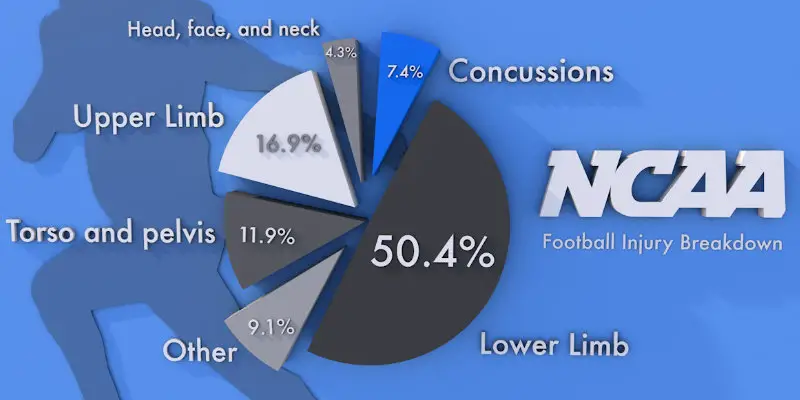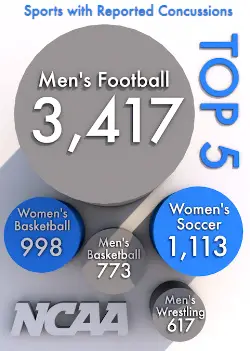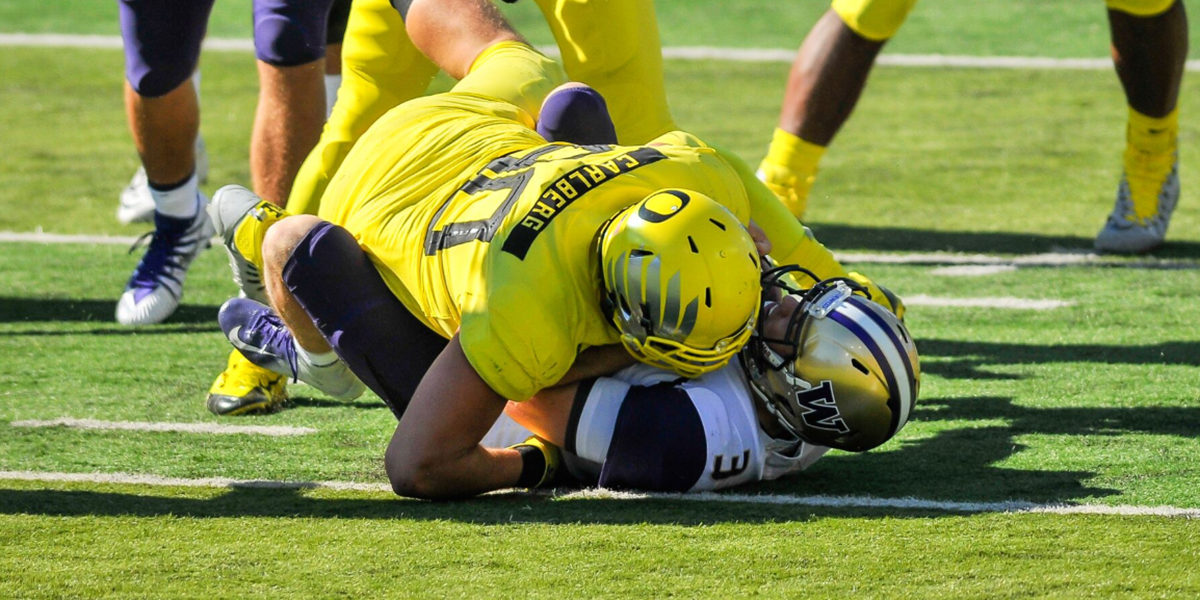Concussions are a simple fact in competitive sports. Every athlete is in danger of getting hit by a another athlete, the ball or the ground each time they step onto the field or court. Below is a chart that lays out the potential for a concussion within each major sport. I was stunned when I saw the information in the chart below, which lists out the top 10 sports in which concussions occur most commonly.
FishDuck.com has a great comments section below, and I’d like you to share your personal experience with concussions or your reactions to any of the statistics in this article, because the way we look at concussions has changed drastically in the past couple decades, and your history and experience would help inform us all on how important this topic is.

Any sports in this Top 10 list surprise you?
If you’re a parent about to send your student-athlete to college, you’ll want to know what the NCAA is doing to protect your child should a concussion occur. I’ve reviewed 65 universities’ concussion protocols. Some I’ve skimmed, and some I’ve read word-for-word. I’ve reviewed each of the Pac-12 universities’ concussion protocols. Let’s look at the NCAA guidelines for concussion protocol put out by the NCAA Sport Science Institute, and let’s review what should be in an effective concussion protocol.
The NCAA Provides Guidelines
The NCAA has very specific guidelines about what should be included in a concussion protocol. Each school in the Power Five conferences (ACC, Big 10, Big 12, Pac-12 and SEC) has their own protocol, but all follow the NCAA guidelines. The first observation is a random one: the protocols differ in page length. For example, the University of Oregon’s concussion protocol is four pages, while North Carolina State University’s concussion protocol is 111 pages. As I reviewed all the concussion protocols, I noticed there were basic steps that appeared in each. They are:
- Education and Baseline Assessment
- Testing protocols when a potential concussion occurs
- Post-concussion management
- Return-to-Play and/or Return-to-Learn Guidelines
Education And Baseline Assessment
If you’re the parent of a student-athlete, your child will have to read an NCAA-approved Fact Sheet on concussions, and will have to sign a document stating that they understand it, as well. The NCAA has a video and additional instructional information on concussions at the disposal of the university to use. Next, your student will provide a personal history of concussions to a healthcare provider, then take several tests. The implementation of the tests can differ by school, but here is a series of standard tests that a school could use:
- The Balance Test or BESS (Balance Error Scoring System — stand on one foot, etc.) is widely used.
- Concussion Assessment Test: SCAT3, SCAT5 or SAC.
- ImPACT Test: A neuropsychology test that has brain-teaser questions. This test is on a public website, and there is a small cost to take it.
- King-Devick Test (with Mayo Clinic): An eye movement test that is used less often but still also online, though only available to groups such as teams or universities.
The signed acknowledgement form and the results from these tests will be kept in your son or daughter’s medical file. That’s important because these exams set a baseline for your child in a healthy state so that, should a concussion occur, a physician has a standard to refer back to when evaluating your child.

Football injury breakdown
When a Potential Concussion Occurs
So when your child has a potential concussion-event, the first thing the NCAA stresses is that the student-athlete will be removed from all activities, whether practice or competition. Protocols require that trainers protect the student-athlete first and get them into an environment where, when they are ready, they can be tested.
What tests do they employ? Those baseline assessment tests above (BESS and SCAT3-SCAT5-SAC, or the ImPACT or King-Devick) are used to immediately identify the status of the athlete. Is the student’s sense of physical balance impaired (Balance: BESS)? How does the athlete feel, and what are the cognitive abilities of the student to repeat names or numbers (SCAT3/SCAT5/SAC and/or ImPACT or King-Devick)?
Coaches have to review and sign their own concussion Fact Sheet to ensure they have read and understand concussion information. I gathered from my review of the documents that, over the last number of years, a new way of looking at concussions has emerged, and the NCAA and its Sport Science Institute are being more proactive in educating people and implementing reforms. There is more transparency in these policies that allows you as a parent or as a student-athlete to look at all of the concussion protocols of any NCAA school.
Post-Concussion Management

Positive findings on concussions
Post-concussion management is what happens after a student-athlete is identified as suffering from a concussion. A monitoring process by medical personnel trained in concussion management starts for the student-athlete, and those baseline tests in the student’s medical file are pulled and used within this process. The goal of this period of time is to allow the brain of the student-athlete time to heal.
If you look at the 65 protocols, you’ll notice some schools have detailed information about post-concussion management, and other schools have only a few lines that explain the process that medical personnel are to follow. If I was sending my student off to a university whose concussion protocol did not list out post-concussion management in detail, but instead discussed how the post-concussion duties are delegated to physicians trained in concussion management, I would feel comfortable with that.
Return-to-Play and Return-to-Learn Guidelines
The return-to-play and return-to-learn guidelines supplement a physician’s post-concussion management of the athlete, and they lay out the incremental process of how one can get back into action, which will take at least a few days if a student has experienced a concussion. The most impressive aspect of my research was learning about how schools thoroughly understood that a concussion is a brain injury, and that the student had to slowly work their way back onto the field and into the classroom.
If you play in the Pac-12 Conference of Champions, you’ll be proud to know that all Pac-12 schools have both return-to-play and return-to-learn guidelines in every concussion protocol to protect both the athlete and the student.

It’s no surprise that football is at the top of the list.
Why So Different?
So if there are 65 different concussion protocols for each school, why are they so different? The truth is, they are all very similar. North Carolina State’s 111-page protocol has over 40 pages (I stopped counting at 40) of inserted NCAA documents. These documents are publicly available on the NCAA website. It’s not necessary, but it can be helpful. A concussion protocol such as Oregon’s, currently at four pages, is not going to include the NCAA Concussion Fact Sheet or an unsigned acknowledgement sheet that the student has read the Fact Sheet because the Athletic Department has those on file to give to the student when appropriate.
Some schools put ancillary documents like these in their protocol, and it beefs up their page count. Nice: yes. Necessary: no. For what it’s worth, Ohio State’s concussion protocol is four pages, and Alabama’s is five. Oregon is in good company with top universities across the country. What the University of Oregon concussion protocol consists of is a summary of guidelines the University will follow, plus there are additional requirements such as the rule that medical personnel be available at both practice and competitive events.
The Oregon concussion protocol has all the necessary guidelines within it, as directed by the NCAA. The great thing is that the NCAA certifies a school after reviewing its concussion protocol, so you can always ask an athletic department if they have a Certificate of Compliance.
In one of the NCAA’s concussion videos, Dr. Bob Cantu states that about 90 percent of concussions resolve in terms of their symptoms within a week. That’s good news. What I gathered from reading all these concussion protocols, and the NCAA’s commitment to providing guidelines to its member institutions, is that concussions are taken seriously. Neuroscience is providing us more information daily, and I suspect the more we learn, more changes will follow.
Is the NCAA Doing Enough?
So what do you think? When you look at the chart for different sports and concussions, is there anything that surprises you? Do you have any insights after reviewing some of the charts? Share you personal history with concussions and which procedures were implemented, if any, before you were sent back on the floor or field.
The Concussion Protocol is a big step forward for the NCAA in implementing the most up-to-date practices and research in its member institutions. Now I ask you: Is the NCAA doing enough to protect student-athletes?
Ugly Duckling
Covington, Kentucky Top Photo Credit: Kevin Cline
 Andrew Mueller, the FishDuck.com Volunteer Editor for this article, works in digital marketing in Chicago, Illinois.
Andrew Mueller, the FishDuck.com Volunteer Editor for this article, works in digital marketing in Chicago, Illinois.
Ugly Duckling was part of a flock that migrated from east of the Cascades many seasons ago, was raised in Willamette Valley Ponds, and is proud to be part of the green and yellow.

